HandBrake is a popular open-source video transcoder known for its ability to compress, convert, and reformat videos across platforms. While it's primarily used for reducing file size and changing codecs, many users wonder: Can HandBrake be used to enhance video quality or upscale a video to a higher resolution?
In this guide, we’ll take a closer look at what HandBrake can (and cannot) do when it comes to improving video quality. We’ll also walk you through how to enable upscaling using the "Allow upscaling" feature introduced in later versions.
💡 Limitations of Using HandBrake for Upscaling:
- HandBrake’s upscaling only enlarges pixels without restoring lost details.
- It cannot reduce noise, remove blur, or fix compression artifacts.
- Lacks AI-powered enhancement, so quality improvements are limited.
Want Real Video Quality Enhancement with AI?
Aiarty Video Enhancer is a powerful AI-driven tool that denoises, deblurs, and upscales videos with impressive detail restoration. It works offline, ensuring your privacy and data security. Redeem a free license code for this 4K video upscaler and enjoy true quality improvement >
Download Aiarty Video Enhancer to enhance and upscale your videos:
Can HandBrake Upscale and Enhance Video Quality?
When it comes to video enhancement, it’s important to understand what HandBrake is designed for—and what it isn’t.
By default, HandBrake is not a video quality enhancer. Its core purpose is transcoding: re-encoding video files into different formats, adjusting resolution, bitrate, and codec settings to achieve compatibility or file size reduction. While these adjustments can make videos look cleaner under certain circumstances (like removing excessive compression), HandBrake does not use any AI or advanced algorithms to restore lost details, reduce noise, or sharpen blurry footage.
As for upscaling, HandBrake does support it—but only to a limited extent. In versions 1.4.0 and later, a feature called "Allow upscaling" was introduced. When enabled, this option allows you to increase the resolution of your video beyond its original dimensions. However, the output will be a larger version of the original video, not necessarily a clearer or more detailed one. In most cases, upscaling with HandBrake simply stretches the pixels, without actually improving visual quality.
In short:
- Yes, HandBrake can upscale videos when you allow it.
- No, HandBrake does not enhance quality in the sense of restoring or improving visual clarity.
How to Enable Upscaling in HandBrake (Step-by-Step)
If you’re looking to upscale a video using HandBrake—for example, converting a 720p video to 1080p or even 4K—you’ll need to manually enable the “Allow upscaling” option. This feature is available in HandBrake 1.4.0 and later, and here’s how you can use it:
Step 1: Install HandBrake 1.4.0 or Later
Download the latest version of HandBrake from the official website. Earlier versions do not include the "Allow upscaling" option in the interface.
Step 2: Import Your Video
Launch HandBrake and click the "Open Source" button to load the video you want to upscale.
Step 3: Go to the Dimensions Tab
In the main window, navigate to the "Dimensions" tab. This is where you control resolution, cropping, and scaling settings.
Step 4: Enable “Allow Upscaling”
In the Dimensions panel, you’ll see a checkbox labeled "Allow upscaling". Check this box to unlock the ability to upscale the video beyond its original resolution.
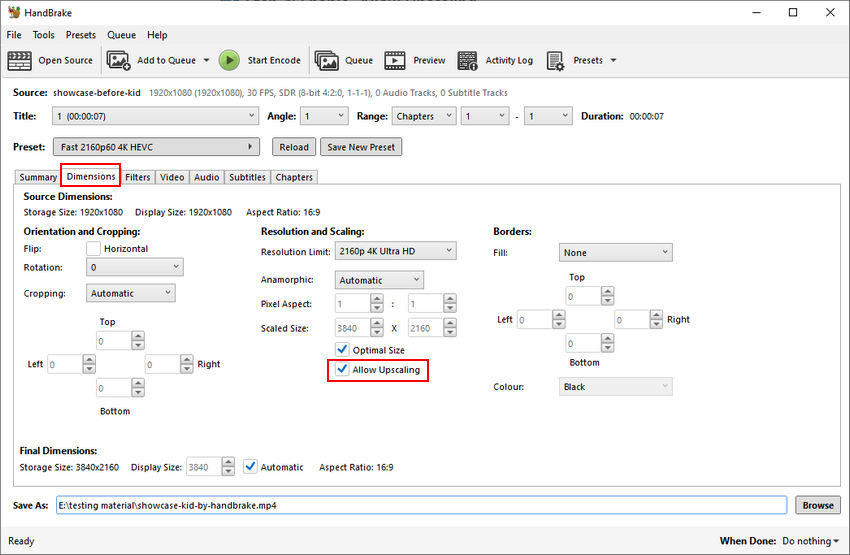
Step 5: Set Your Target Resolution
Manually enter your desired resolution in the Width and Height fields (e.g., set to 1920 × 1080 for 1080p or 3840 × 2160 for 4K). HandBrake will now upscale the video during the encoding process.
Step 6: Choose Video Codec and Output Settings
Switch to the Video tab to select the desired codec (like H.264 or H.265), quality settings, and frame rate.
Learn More: Check the Handbrake Best Settings for the Clearest Video Output
Step 7: Start Encoding
Click "Start Encode" to begin processing your video. The result will be a higher-resolution version of your input, but keep in mind: this does not mean improved image detail.
So, Did HandBrake Actually Improve the Video Quality?
To find out, we ran a simple test.
Below is a side-by-side comparison of a cropped region from the same video frame—first at the original 1920×1080 resolution, and then after being upscaled to 3840×2160.
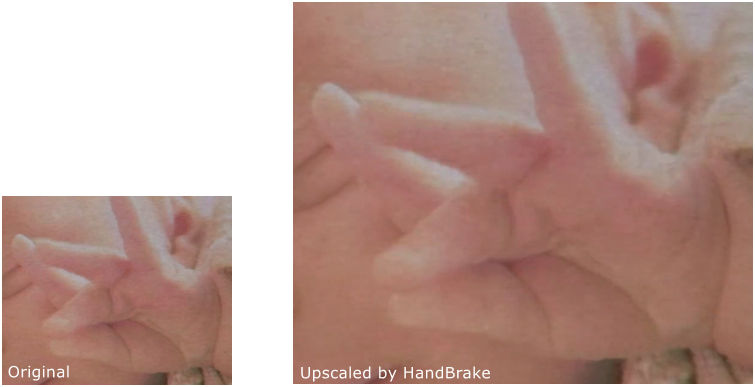
As you can see, the upscaled version is larger in size, but the overall quality remains the same. The noise is still present, and no new details have been restored. This confirms that while HandBrake can upscale resolution, it doesn't truly enhance the visual quality of the video.
Limitations of Using HandBrake for Upscaling
While HandBrake offers basic upscaling capabilities, there are several key limitations to keep in mind—especially if your goal is to improve video quality, not just increase resolution.
1. No Real Quality Enhancement
HandBrake does not use AI or advanced processing to enhance visuals. When you upscale a video, it simply enlarges the existing pixels. The result may be a larger video, but not a clearer or more detailed one.
2. No Noise Reduction or Deblurring
Videos with noise, compression artifacts, or motion blur won’t be improved by HandBrake. It lacks tools for denoising, deblurring, or sharpening—common features in AI-powered video enhancers.
3. Manual and Technical
Upscaling in HandBrake requires manual configuration and some technical understanding of resolution, bitrate, and codec settings. There’s no automatic mode or intelligent enhancement workflow.
4. Results Can Look Soft or Artificial
When increasing resolution without restoring details, the final output can appear soft, stretched, or even worse than the original—especially if viewed on larger screens.
If you’re looking for true video enhancement, with smarter detail restoration, noise reduction, and sharpness correction, a different approach is needed.
Best HandBrake Alternative for Video Upscaling and Quality Enhancement
If you want to upscale and truly enhance your video quality, Aiarty Video Enhancer is a powerful choice.
Powered by advanced AI models, Aiarty Video Enhancer is designed to go beyond basic upscaling. It analyzes each frame to intelligently enhance clarity, reduce video compression artifacts, sharpen edges, and recover fine textures—transforming low-quality footage into visually stunning results.
Here's a quick comparison:
How to Enhance and Upscale Video with Aiarty Video Enhancer
Using Aiarty Video Enhancer is simple—even for beginners.
Step 1: Download and Install
Aiarty supports both Windows and Mac. Just click the download button below to get the installer.
Step 2: Import Your Video
Open Aiarty Video Enhancer and click the "+" button to add the video you want to upscale and enhance.
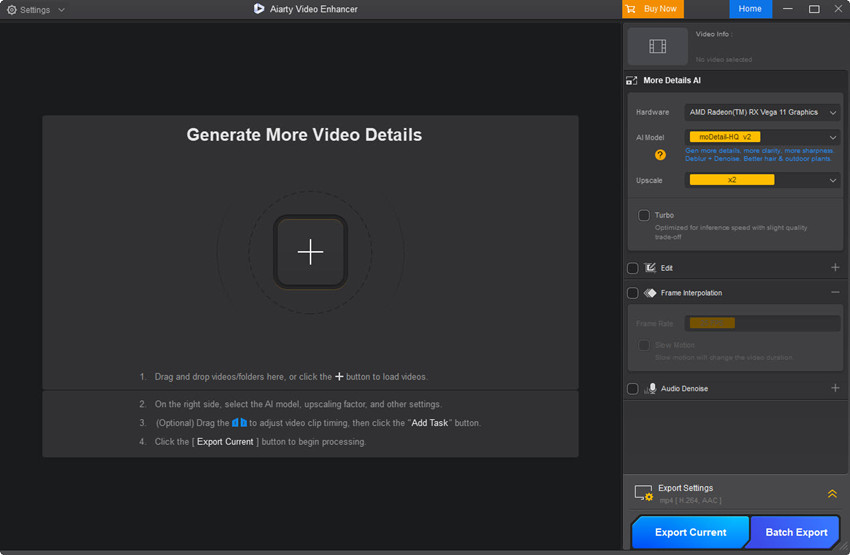
Step 3: Select AI Model
Aiarty offers three AI models tailored for different video types. Choose the one that best fits your footage.
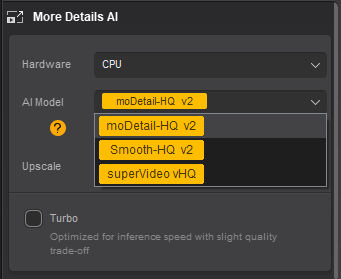
Step 4: Specify Upscale Options
You can select a scaling factor (e.g., 2x, 4x), choose a preset resolution (720p, 1080p, 2K, 4K), or enter a custom resolution.
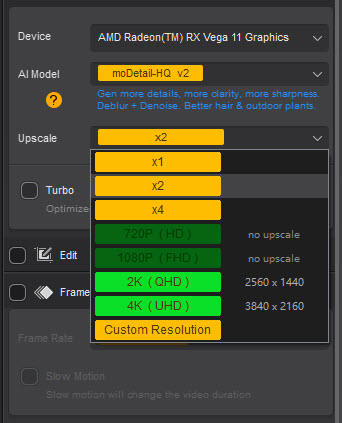
Step 5: Preview the Results
After settings are applied, click the Preview button. Aiarty will generate a preview allowing you to compare the original and enhanced versions side by side.
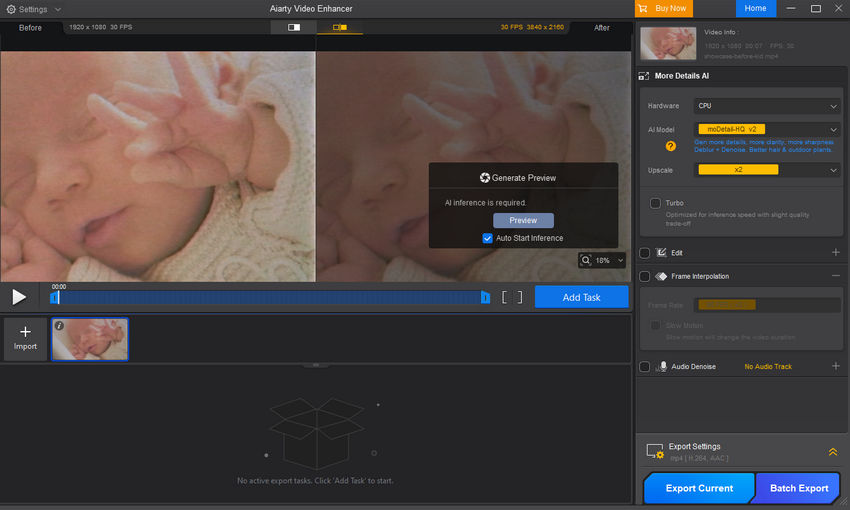
Step 6: Export the Final Video
Once satisfied, click Add Task and then Export Current to start processing. During upscaling, Aiarty automatically applies deblurring, noise reduction, artifact removal, and detail restoration to significantly improve video quality.
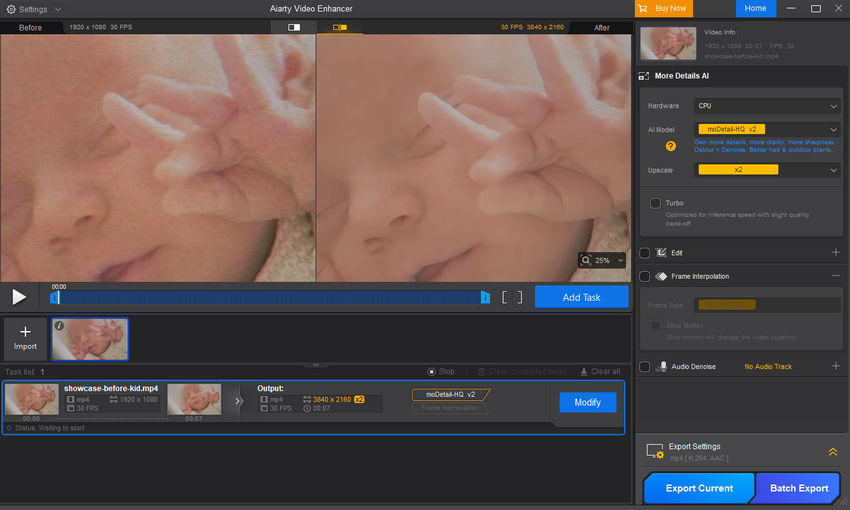
Below is an example showing Aiarty Video Enhancer upscaling a video from 1080p to 4K. We can notice the clear improvement in quality with a cleaner, sharper image.
For more test examples, check out this YouTube video made by another user.
 Frequently Asked Questions
Frequently Asked Questions
HandBrake is primarily a video transcoder and compressor. While it can resize and upscale videos, it does not enhance the actual image quality or restore lost details. Upscaling with HandBrake simply enlarges pixels, which may result in soft or blurry output.
No. HandBrake does not include AI-powered enhancement features. Its upscaling is a basic pixel resizing process without advanced noise reduction, sharpening, or detail restoration.
In HandBrake 1.4.0 and later, you can enable the “Allow upscaling” option in the Dimensions tab. After enabling it, manually set a higher resolution than the original video to upscale during encoding.
HandBrake alone isn’t ideal for improving old or low-quality footage. It can change the format or resolution, but it won’t fix noise, blur, or compression artifacts.
While HandBrake is free and open-source for encoding, it lacks video enhancement features. AI-powered tools like Aiarty Video Enhancer offer free trials and provide noise reduction, deblurring, and real quality improvements.
Yes, by enabling “Allow upscaling” and setting the output resolution to 3840×2160, HandBrake can upscale videos to 4K. However, the visual quality won’t improve beyond pixel enlargement.